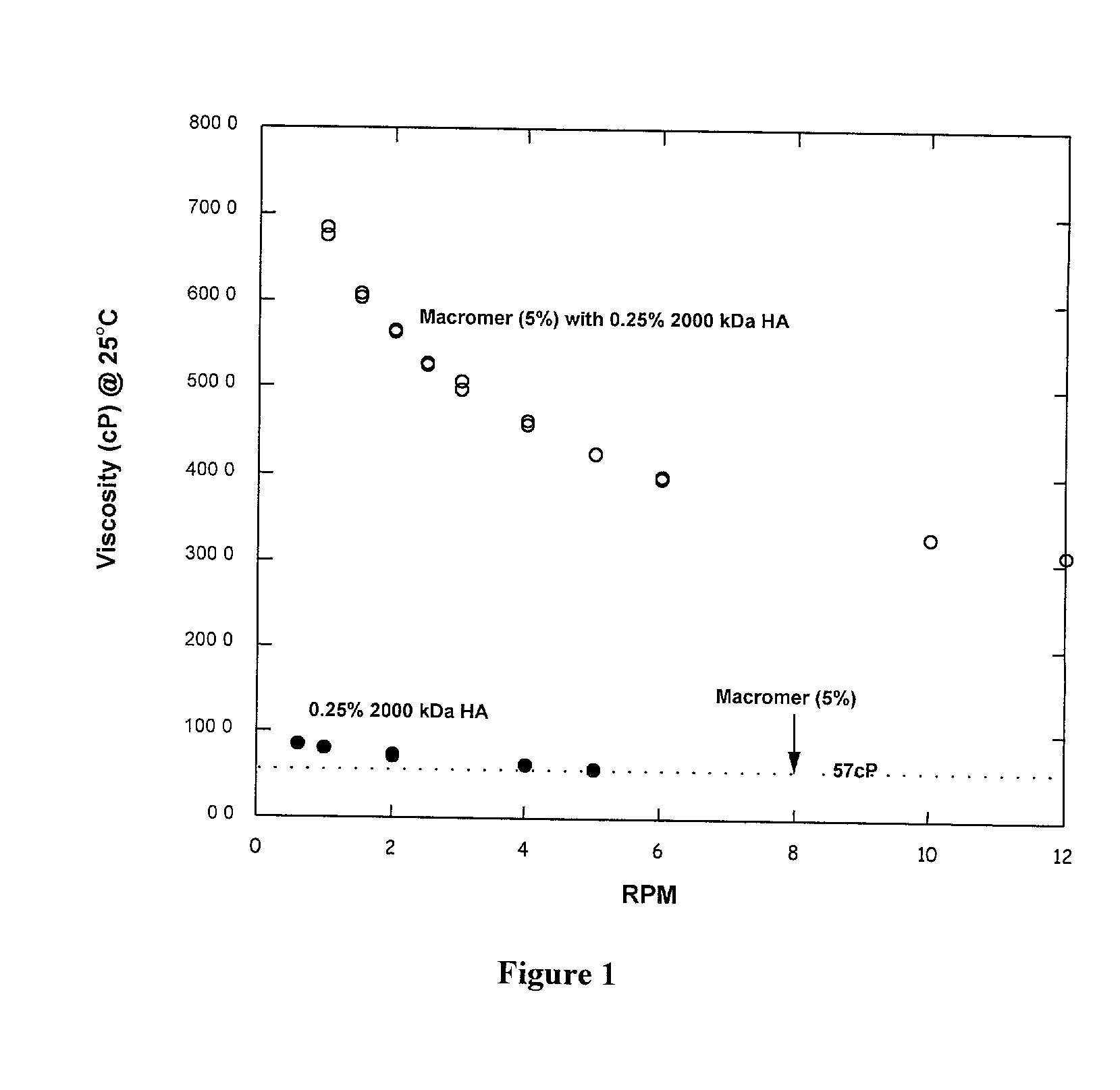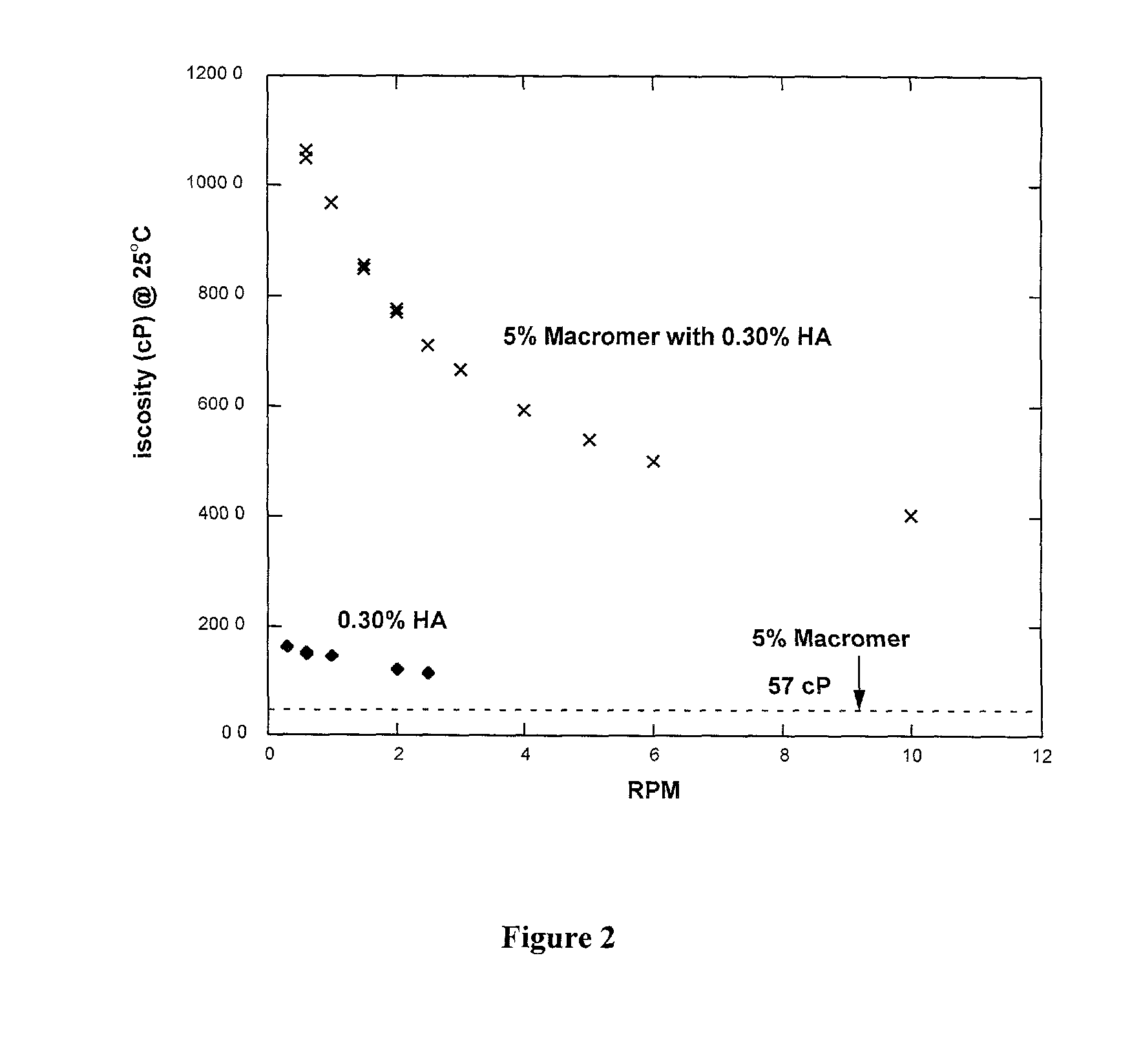Polyalkylene glycol viscosity-enhancing polymeric formulations
a technology of polyalkylene glycol and viscosity enhancement, which is applied in the field of polyalkylene glycolhyaluronic acid formulations, can solve the problems of difficult to achieve a sufficiently high viscosity, unable to facilitate cell entry in tissue engineering applications, and pags also have a tendency to swell, so as to achieve constant viscosity, increase shear rate, and change in apparent viscosity
- Summary
- Abstract
- Description
- Claims
- Application Information
AI Technical Summary
Benefits of technology
Problems solved by technology
Method used
Image
Examples
example 1
[0062] Viscosity and Modulus of 20KTLA and 35KTLA solutions with and without 1% HA (500 kDa).
[0063] A 10 g aqueous formulation consisting of 1 g 20KTLA, 54 mg TEOA, 80 mg mono-potassium phosphate (KPhos), 40 mg vinylcaprolactam (VC), and 0.4 mg of Eosin-Y was prepared. To 5 g of this solution, 50 mg of 500 kDa sodium hyaluronate (HA) was added. Similarly, a 10 g aqueous formulation consisting of 2 g 35KTLA, 120 mg TEOA, 102 mg KPhos, 0.4 mg Eosin-Y, and 50 mg VC was prepared. To 5 g of this solution, 50 mg of 500 HA was added.
[0064] Table 1 summarizes the viscosities for each solution with and without HA. The viscosities of these solutions were obtained at 25.degree. C. The moduli of the hydrogels, obtained after photopolymerization using visible light for 40, 80 or 180 seconds at 100 mW / cm.sup.2, are also summarized in Table 1.
[0065] The viscosities of the formulations with 1% 500 kDa HA were significantly higher than the corresponding macromer formulations without the added HA. Th...
example 2
[0066] Gel Formation by Aqueous Solutions Containing 35KTLA and HA.
[0067] A first aqueous 5.028 g formulation was prepared containing 0.9005 g 35KTLA, 0.0302 g HA, 0.03 g ferrous gluconate (Fe-Gluconate), and 25 .mu.L VC. A second aqueous 5.028 g formulation was prepared containing 0.9005 g 35KTLA, 0.0302 g HA, 126.3 ppm t-Butylperoxide, and 25 .mu.L VC.
[0068] Five drops of the first solution were added to 5 drops of the second solution, and the mixture was rapidly mixed resulting in the formation of a hydrogel almost instantaneously (i.e., in less than 2 seconds). The rapid formation of a gel suggests that the presence of HA did not interfere with chemical initiation reaction between ferrous ion and hydroperoxide.
example 3
[0069] Delivery of Aqueous Solutions Containing 35KTLA and HA.
[0070] The first aqueous solution described in Example 2 was loaded into one syringe and the second aqueous solution described in Example 2 was loaded into a second syringe. Both syringes were placed in a dual syringe holder. A device containing a 1 inch-long static mixer was attached to the end of the syringes. When the aqueous solutions were released from the syringes in a 1:1 ratio, the mixture gelled almost instantaneously.
PUM
| Property | Measurement | Unit |
|---|---|---|
| Fraction | aaaaa | aaaaa |
| Fraction | aaaaa | aaaaa |
| Percent by mass | aaaaa | aaaaa |
Abstract
Description
Claims
Application Information
 Login to View More
Login to View More - R&D
- Intellectual Property
- Life Sciences
- Materials
- Tech Scout
- Unparalleled Data Quality
- Higher Quality Content
- 60% Fewer Hallucinations
Browse by: Latest US Patents, China's latest patents, Technical Efficacy Thesaurus, Application Domain, Technology Topic, Popular Technical Reports.
© 2025 PatSnap. All rights reserved.Legal|Privacy policy|Modern Slavery Act Transparency Statement|Sitemap|About US| Contact US: help@patsnap.com



